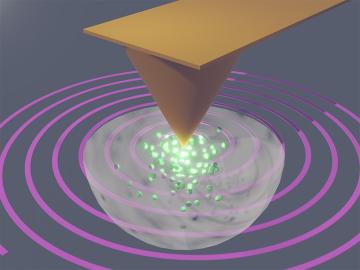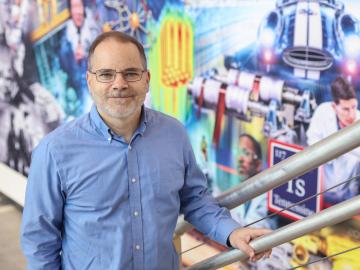Filter News
Area of Research
News Type
Date
News Topics
- 3-D Printing/Advanced Manufacturing (3)
- Advanced Reactors (1)
- Artificial Intelligence (8)
- Big Data (6)
- Bioenergy (4)
- Biology (4)
- Biomedical (2)
- Biotechnology (3)
- Buildings (6)
- Chemical Sciences (8)
- Clean Water (3)
- Climate Change (11)
- Composites (2)
- Computer Science (7)
- Critical Materials (3)
- Decarbonization (8)
- Energy Storage (6)
- Environment (10)
- Exascale Computing (1)
- Frontier (1)
- Fusion (2)
- Grid (1)
- High-Performance Computing (6)
- Isotopes (3)
- ITER (1)
- Machine Learning (4)
- Materials (5)
- Materials Science (3)
- Mathematics (1)
- National Security (4)
- Net Zero (1)
- Neutron Science (2)
- Nuclear Energy (1)
- Partnerships (2)
- Physics (1)
- Polymers (3)
- Quantum Computing (1)
- Security (1)
- Simulation (3)
- Statistics (2)
- Sustainable Energy (5)
- Transportation (4)
Media Contacts

Research led by ORNL’s Marti Checa and Liam Collins has pioneered a groundbreaking approach described in the journal Nature Communications that enables visualizing charge motion at the nanometer level, or one billionth of a meter, but at speeds thousands of times faster than conventional methods.

David Sholl, director of the Transformational Decarbonization Initiative at ORNL, has been elected a member of the National Academy of Engineering for his contributions in addressing large-scale chemical separation challenges, including carbon dioxide capture, using quantitative materials modeling.

ORNL climate modeling expertise contributed to a project that assessed global emissions of ammonia from croplands now and in a warmer future, while also identifying solutions tuned to local growing conditions.

Ilenne Del Valle is merging her expertise in synthetic biology and environmental science to develop new technologies to help scientists better understand and engineer ecosystems for climate resilience.

ORNL researchers have developed a novel way to encapsulate salt hydrate phase-change materials within polymer fibers through a coaxial pulling process. The discovery could lead to the widespread use of the low-carbon materials as a source of insulation for a building’s envelope.

ORNL employees contributed over $828,000 to local nonprofits through the lab’s employee giving programs in 2023. ORNL’s managing contractor, UT-Battelle, provided an additional $139,600 in support of employee efforts. In addition, ORNL employees recorded over 1,497 volunteer hours, serving 56 nonprofits. With the value of these volunteer hours estimated at $36,232, total employee-led contributions for 2023 were valued at more than $1 million.

EPB, ORNL announce plans for research collaborative focused on energy resilience, quantum technology
EPB and ORNL marked 10 years of collaboration with the announcement of the new Collaborative for Energy Resilience and Quantum Science. The new joint research effort will focus on utilizing Chattanooga’s highly advanced and integrated energy and communications infrastructure to develop technologies and best practices for enhancing the resilience and security of the national power grid while accelerating the commercialization of quantum technologies.

Scientists at the Department of Energy’s Oak Ridge National Laboratory are using a new modeling framework in conjunction with data collected from marshes in the Mississippi Delta to improve predictions of climate-warming methane and nitrous oxide.

Four ORNL teams and one researcher were recognized for excellence in technology transfer and technology transfer innovation.

Gina Tourassi, associate laboratory director for computing and computational sciences at the US Department of Energy’s (DOE’s) Oak Ridge National Laboratory, has been named a fellow of the Institute of Electrical and Electronics Engineers, the world’s largest organization for technical professionals.




